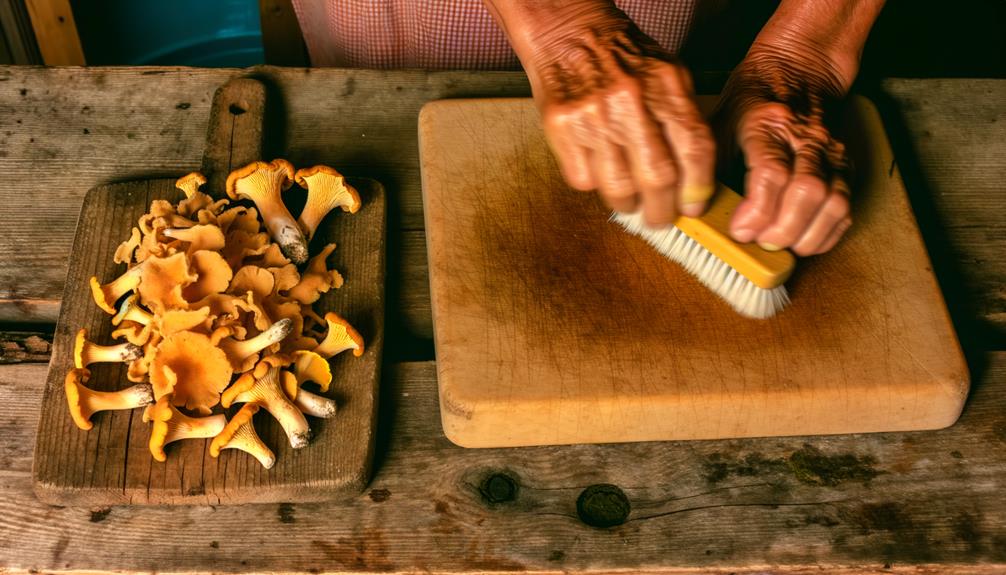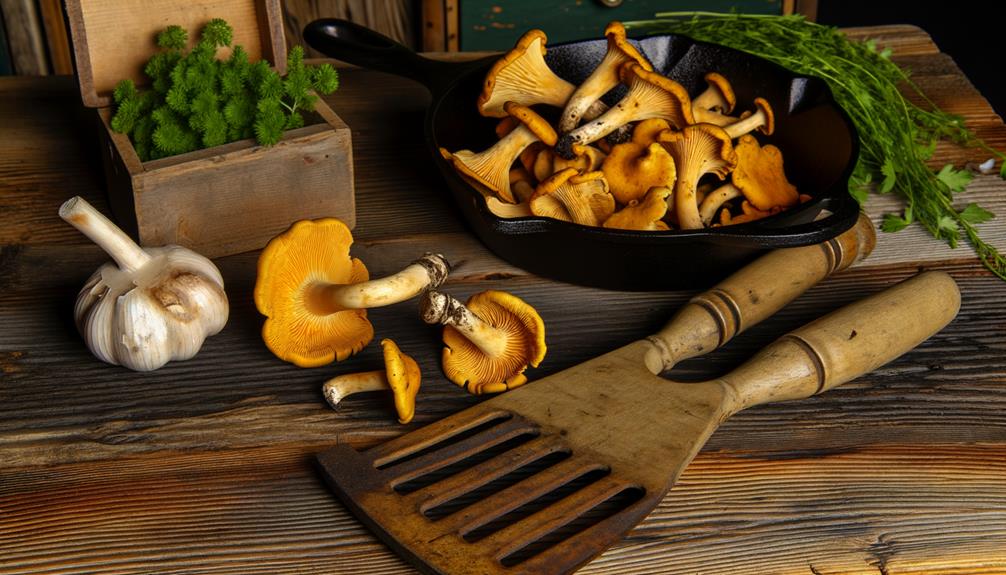First, I clean the chanterelles, cutting away any tough stems and giving a quick rinse to guarantee a perfect sauté. I pat them dry to secure a flawless sauté. Next, I sauté them in a dry skillet on high heat to eliminate excess moisture. I add butter for a rich, creamy texture, and some garlic for flavor. Quick cooking on high heat keeps them firm and flavorful. Salt and pepper enhance the natural taste, and a splash of white wine amplifies the flavor further. But that's just the basics, there's still more to explore when you venture deeper into cooking chanterelles.
Chanterelles' Culinary Background
Did you know that chanterelles, with their golden color and unique trumpet shape, are a versatile ingredient in many culinary dishes? Whether you're a professional chef or a home cook, these vibrant mushrooms can elevate your cooking. You can find them in the wild, or cultivate them for culinary use.
When cooked, chanterelles yield a unique flavor profile that can be further enhanced by adding herbs, lemon juice, or vinegar. They can be served as a side dish, main dish, or garnish. Their versatility in the kitchen is truly impressive.
Cooking chanterelles isn't a complicated process. Start by cleaning them thoroughly to remove any dirt or debris. Then, heat a pan over medium heat. Once the pan is hot, add the chanterelles. It's important to cook chanterelles on dry heat, as they tend to release a lot of water.
Proper storage is also key to maintaining their freshness. I usually store them in a plastic bag with airflow and a paper towel in the refrigerator. This way, they're ready to use whenever I'm in the mood to cook something special with chanterelles.
Essential Chanterelle Recipe Components
Now that we've covered the basics of cooking and storing chanterelles, let's talk about the key ingredients that can really make these mushrooms shine in your recipes. The classic Sautéed Chanterelle Mushroom dish is simple, letting the mushroom's unique flavor take center stage.
First, I like to pan fry chanterelles on high heat. This removes any excess moisture and concentrates the mushroom's earthy flavor. It also gives them a wonderful velvety texture.
Butter is another essential component. It adds a rich, creamy element that pairs beautifully with the chanterelles. I also recommend adding garlic for an extra punch of flavor.
Finally, don't forget the seasonings. A little salt and pepper go a long way in enhancing the natural flavors of the chanterelles.
Here's a quick reference table to help you with the essential components for cooking chanterelles:
| Ingredient | Quantity | Function |
|---|---|---|
| Chanterelles | 1 lb | Main ingredient |
| Butter | 2 tbsp | Adds creaminess and rich flavor |
| Garlic | 2 cloves | Enhances flavor |
| Salt and Pepper | To taste | Seasoning |
| High Heat | As needed | Concentrates flavor and texture |
With these components, you're well on your way to cooking chanterelles that'll impress anyone.
Chanterelle Preparation Method

To prepare chanterelles for cooking, you'll first want to gently clean them by rubbing off any dirt with a paper towel, steering clear of soaking them as this can lead to sliminess. Chanterelles have a high water content, so to get rid of the excess moisture, I like to sauté the mushrooms in a dry pan for a few minutes before adding any fat.
Once the mushrooms are nice and dry, it's time to add some flavor. Here are my three go-to steps:
- Melt a generous knob of butter in the pan. This gives the chanterelles a rich, velvety texture.
- Add a splash of white wine. This deglazes the pan, lifting all those delicious caramelized bits off the bottom, and imparts a subtle acidity that balances the earthiness of the mushrooms.
- Finally, I trim any tough or fibrous parts from the stems before serving.
Expert Tips
Now, let's progress to some expert tips that will elevate your chanterelle cooking skills to the next level.
We'll discuss the top methods to cleanse these delicate mushrooms, the art of sautéing them just right, and how to prevent overcooking.
These techniques are essential for unleashing the full potential of chanterelle's distinct flavor and texture.
Cleaning Chanterelle Mushrooms
Before cooking, it's vital to properly clean your chanterelles by cutting off any dirty stems and brushing off the dirt. I'd also suggest a quick rinse under cold water to clear any remaining grit.
After cleaning, drain them on a paper towel. You don't want damp mushrooms hitting your frying pan of olive oil and butter heated over medium-high heat. The result? Soggy mushrooms, not the golden-brown delicacy you're aiming for. Dry mushrooms are key to a perfect sauté.
Once cleaned and dried, store your chanterelles in a paper bag in the fridge. They'll keep fresh for a week to ten days. Cleaning chanterelles appropriately is an important step towards creating a delicious meal.
Sautéing Techniques
When it comes to sautéing chanterelles, there's a few expert techniques that can elevate their flavor and texture. Begin by sautéing the mushrooms in a dry skillet. This helps to remove excess moisture, concentrating the chanterelles' flavor.
Once they've started to release their moisture, I add butter. It not only adds richness but also enhances their overall taste. Sautéing them whole is another tip. It preserves their texture and prevents too much water from being released.
Pairing them with garlic is a personal favorite of mine. The garlic's aroma merges with the butter, creating a flavorful foundation for the chanterelles. Remember, it's all about coaxing out their flavor while maintaining a pleasing texture.
Avoiding Overcooking
To keep chanterelles from becoming oily and tough, it's vital to avoid overcooking them. When you cook chanterelle mushrooms, it's optimal to do it quickly on high heat. I prefer to use a Cast Iron pan for this, as it distributes the heat evenly.
I add the butter and let it melt, then add the chanterelles. As they cook, they'll turn a beautiful golden brown. At this point, it's important to remove from heat promptly. If there's excessive moisture, you can use water to remove it. This way, the mushrooms stay firm and don't release too much water.
Final Thoughts
In conclusion, it's clear that with the correct cooking and storage methods, you can truly savor the unique tastes of chanterelles in a variety of dishes. The best way to cook these earthy delights is by sautéing them. This method allows the chanterelles to maintain their distinctive texture and release their nutty flavors, enhancing the taste of any dish they're added to.
It's vital to avoid soaking the mushrooms in water. This could make them slimy, which you definitely don't want. Instead, clean them gently with a paper towel to preserve their natural state. Pairing them with various herbs, a squeeze of lemon juice, or a dash of vinegar can further elevate their flavor, adding a complementary layer to their inherent earthiness.
Storing chanterelles properly is just as essential as cooking them correctly. Place them in a plastic bag with a paper towel and store in the refrigerator. This method prolongs their shelf life, ensuring you can enjoy the delightful flavors of these mushrooms whenever you desire. Remember, the joy of cooking chanterelles lies in celebrating their distinct, natural flavors. So, treat them with care and enjoy!
